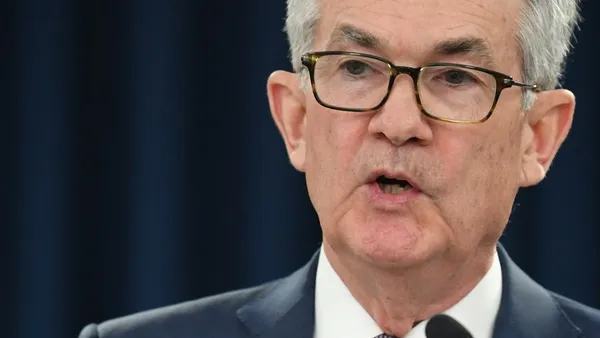Dive Brief:
- The outlook for the highest inflation rate in four decades hinges on whether the tight U.S. labor market continues to fuel the fastest increase in wages since the early 1980s, according to former Treasury Secretary Lawrence Summers.
- “I don’t think there’s a durable reduction in inflation without a meaningful reduction in wage growth,” Summers said Tuesday. “Right now with the labor market so tight, I don’t see such a meaningful reduction in wage growth.”
- The U.S. economy may be headed toward a downturn, Summers warned during a Washington Post webcast. “When inflation has been above 4%, unemployment has been below 4%, we’ve always had a recession within the next two years,” he said. “The likelihood is that we’re not going to get through this with a soft landing.”
Dive Insight:
CFOs for months have raised compensation as pandemic lockdowns and reluctance among workers to rejoin the labor force shrunk the pool of available labor. The employment cost index during the first quarter rose 1.4% for a 4.5% year-over year increase.
In April, the consumer price index increased 8.3% year-over-year, while the Fed’s preferred measure of inflation — the core personal consumption expenditures price index — rose 4.9%, according to the Labor Department.
The persistent price pressure increases concerns that consumer expectations for low long-term inflation will fade, prompting demands for higher pay and triggering a self-reinforcing upward spiral in prices and wages.
“The Fed was way too slow to recognize the gravity of the gathering inflation storm even though there was substantial evidence of it,” Summers said.
Fed Chair Jerome Powell has said that curbing inflation is a top priority. The central bank has increased the benchmark interest rate twice this year from a record low to a range of between 0.75% and 1%. It has also committed to trimming its $9 trillion balance sheet.
Policymakers lean toward raising the federal funds rate by a half percentage point at each of their next two meetings in June and July, according to minutes of their May 3-4 meeting released last week.
The Fed faces the challenge of raising borrowing costs enough to reduce inflation closer to its 2% target but not so high that it undercuts employment or economic growth, according to economists.
“I’ve been heartened in recent weeks and even the last several months by Chairman Powell’s statements about the importance and centrality of inflation,” Summers said, adding that believes that the central bank needs to raise the main interest rate to at least 3% to 4%.
“That’s the kind of increase in interest rates that at a minimum we’re going to need if we’re going to have a prospect of containing inflation,” he said, highlighting the risks of a slowdown. “A soft landing is going to be very difficult in these circumstances.”
“I don’t see how we can get inflation to substantially decelerate without wage inflation falling substantially, and I don’t see any reason to think wage inflation will fall substantially unless there’s a substantial loosening in labor markets, which would mean higher unemployment,” Summers said.
A decline of inflation over the next 12 months to 3% instead of to the Fed’s 2% target may prompt policymakers to raise the main interest rate to 4%, according to Ryan Sweet, senior director of economic research at Moody’s Analytics.
“While this is aggressive enough to get inflation back to target, it triggers a so-called growth recession, wherein real [gross domestic product] GDP grinds to a halt and the jobless rate rises to just over 5% by the end of next year,” Sweet said in a report. The unemployment rate in April was 3.6%.
Tight labor markets are just one spur to persistent inflation, according to Marc Goldwein, senior policy director at the Committee for a Responsible Federal Budget. An increase in consumer inflation expectations, $2.3 trillion in excess savings and new shocks to the supply of commodities such as oil and grain may also sustain prices pressures.
On the other hand, several factors such as declining equity prices, an increase in the supply of labor and an untangling of supply chains may help slow inflation in coming months, Goldwein told the National Economists Club on May 26.
“It’s very difficult to forecast what’s going to happen to [inflation] expectations,” Summers said.
“Nobody can forecast what’s going to happen to oil prices — nobody can forecast what’s going to happen to commodity prices,” he said. “They’re things that right now are very much in the realm of geopolitics.”
President Joe Biden, in a meeting with Powell on Tuesday, reiterated his commitment to the independence of the Fed in its effort to curb inflation, Brian Deese, director of the National Economic Council, said at a White House news conference.
“Part of providing that independence is to stay out of the business of commenting on tactics, timing or otherwise on the monetary policy side,” Deese said. “So you can expect that from us going forward.”
Biden “agrees with the assessment that the team at the Federal Reserve is making and that the chair Powell is making as well,” he said.
Biden, while identifying the fight against inflation as his top economic priority, called on Congress to pass legislation providing clean energy tax credits and investments.
Writing in an op-ed in The Wall Street Journal, Biden on Tuesday proposed reducing prices through improved infrastructure, expanding the availability of housing, reducing the price of drugs by enabling Medicare to negotiate with drug companies and removing supply chain bottlenecks. He also called on Congress to help reduce the federal budget deficit.















